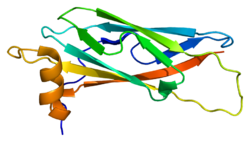VAMP-Associated Protein A ( or Vesicle-Associated Membrane Protein-Associated Protein A) is a protein that in humans is encoded by the VAPA gene.[5][6][7] Together with VAPB and VAPC it forms the VAP protein family. They are integral endoplasmic reticulum membrane proteins of the type II and are ubiquitous among eukaryotes.[8]
VAPA is ubiquitously expressed in human tissues[5] and is thought to be involved in membrane trafficking by interaction with SNAREs,[9] in regulation of lipid transport and metabolism,[8] and in the Unfolded Protein Response (UPR).[8]
- ^ a b c GRCh38: Ensembl release 89: ENSG00000101558 – Ensembl, May 2017
- ^ a b c GRCm38: Ensembl release 89: ENSMUSG00000024091 – Ensembl, May 2017
- ^ "Human PubMed Reference:". National Center for Biotechnology Information, U.S. National Library of Medicine.
- ^ "Mouse PubMed Reference:". National Center for Biotechnology Information, U.S. National Library of Medicine.
- ^ a b Nishimura Y, Hayashi M, Inada H, Tanaka T (January 1999). "Molecular cloning and characterization of mammalian homologues of vesicle-associated membrane protein-associated (VAMP-associated) proteins". Biochemical and Biophysical Research Communications. 254 (1): 21–6. doi:10.1006/bbrc.1998.9876. PMID 9920726.
- ^ Weir ML, Klip A, Trimble WS (July 1998). "Identification of a human homologue of the vesicle-associated membrane protein (VAMP)-associated protein of 33 kDa (VAP-33): a broadly expressed protein that binds to VAMP". The Biochemical Journal. 333 ( Pt 2) (2): 247–51. doi:10.1042/bj3330247. PMC 1219579. PMID 9657962.
- ^ "Entrez Gene: VAPA VAMP (vesicle-associated membrane protein)-associated protein A, 33kDa".
- ^ a b c Lev S, Ben Halevy D, Peretti D, Dahan N (June 2008). "The VAP protein family: from cellular functions to motor neuron disease". Trends in Cell Biology. 18 (6): 282–90. doi:10.1016/j.tcb.2008.03.006. PMID 18468439.
- ^ Weir ML, Xie H, Klip A, Trimble WS (August 2001). "VAP-A binds promiscuously to both v- and tSNAREs". Biochemical and Biophysical Research Communications. 286 (3): 616–21. doi:10.1006/bbrc.2001.5437. PMID 11511104.





